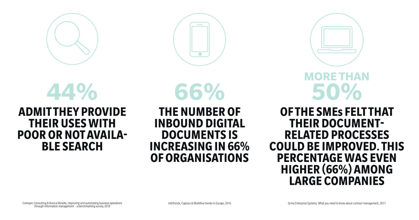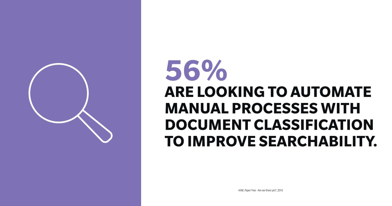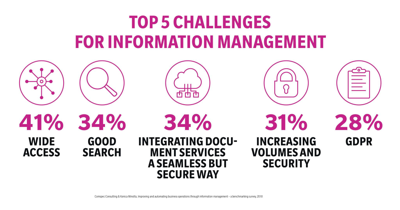Today’s businesses are awash with data – with a potentially limitless supply of information and insight always seemingly within reach. Yet as the volume of data grows, the challenge of locating what you need when you need it – particularly across multiple applications and discrete data silos – is only increasing. Only 24% of companies feel they provide their users with basic search functionalities, with 44% admitting these are poor or not available.[1] The answer to this situation is smart search software. Solutions which enable advanced search within existing data archives without the need to move files, are becoming a key asset for process efficiency. Konica Minolta manages to combine the convenience and simplicity of consumer search engines with all the power, control and security of an enterprise solution.

Businesses are experiencing an exponential increase in data. Two thirds of organisations are facing a 66% increase in inbound documents alone. [2] Despite the immense promise of big data solutions, the reality is that faced with this data deluge, the majority of businesses are still struggling to swim rather than learning to master fishing. 66% of large companies feel that their document-related processes could be improved. This challenge is even felt in small and medium sized businesses with more than 50% feeling a need to improve processes. [3]
Knowledge workers in particular are now spending ever more time trying to find specific information, wasting resource on searches as well as incurring the opportunity costs that face businesses that are slow to react. What seems like an unavoidable irritation aggregates to a significant and costly problem. Where on average it takes 18 minutes [4] to search for an individual document, employees overall can spend 9.3 hours per week [5] searching for information. That big picture view is astonishing, but it is important to consider that searches often involve trying to locate information from multiple applications, in multiple formats – including images of scanned paper documents – and across different digital archives. And one can’t assume that a search will result in success: research indicates that 7.5% of documents will get lost. [6]

While digitisation marks an important milestone towards becoming a true data-driven organisation, there is a real need to unlock the value of digital archives by adding searchability. Indeed, 56% of organisations are looking to automate manual processes while adding document classification that will improve searchability. [7] They also rate searchability – at 34% – as the second most important challenge in the setup of Information Management, right after wide access possibilities at 41%. [8]
Implementing efficient Enterprise Search with Konica Minolta
“When setting up an Enterprise Search solution for a customer, we take a holistic view that places their needs and infrastructure at the centre of everything we do,” explains Cobussen. When working with customers to implement Enterprise Search, Konica Minolta’s consultants prioritise their needs and current data environments as overriding considerations. Cobussen adds that “even if they have a silo structure, our customers are able to keep their established systems and archive. This is hugely valuable, as being able to build on their existing data archive infrastructure is a significant advantage to organisations seeking to implement a search solution. In other words, we keep the data where it is and make it effortless to find it.”
Taming your data with Konica Minolta Enterprise Search
Konica Minolta provides a variety of powerful Enterprise Search solutions. One of them is dokoni FIND. Providing a single point of access across all applications, the comprehensive Enterprise Content Management module is a smart search engine that indexes all available data and files, abstracting content from disparate data silos and capturing everything within a secure Universal Index.
Special data migration or transfer processes are not necessary, and the solution also offers automatic conversion of content. By enabling universal data access, all data silos (including external data archives) are rapidly searchable from a single screen without the need to switch between programs. This solution comes built in to the application, which has been created to comply with whatever security scheme companies already have in place. Users can access only the content they are authorised to see.
Customer voices: Grönlund Services Oy
With over 130 cleaning and support services, Grönlund Services Oy is a professional cleaning company that has been serving customers in Finland for over 25 years. With its wide variety of customers and numerous mobile employees that are constantly on the move, finding documents fast is an essential business process. Despite this, Grönlund’s employee faced significant difficulty finding documents if they did not know the exact file name.
The company sought to integrate metadata and full text search into their Enterprise Search. On evaluating the available solutions, Konica Minolta’s dokoni Find was found to best meet Grönlund’s needs.
In line with its customer-centric approach, Konica Minolta initially conducted a comprehensive mapping of the client environment, and tested a range of implementation methods for the centralised search function. The implementation of dokoni FIND delivered fast, easy to use search across the organisation.
Customer voices: SSP AG
SSP AG was established in 1977. The company consists of over 120 architects, engineers and industry experts at its offices in Bochum and Karlsruhe who all share the common goal of integrated planning. This is why they formed a successful partnership with Konica Minolta in the area of application programs – more specifically on enterprise search. The company handles a broad variety of documents in different formats on a daily basis, so keeping them organised, easy to access and find is central to the business success of the company.
The decisive advantage of Enterprise Search
As the proliferation of enterprise data accelerates, the ability to have information quickly at hand irrespective of where it is or where the end user is, is providing businesses with a decisive advantage. This is particularly true as working patterns evolve to demand greater levels of flexibility and mobility. “With Konica Minolta Enterprise Search solutions, this way of working becomes not only a possibility but a reality for our customers. We are constantly working on solutions for the future, today,” Cobussen concludes. Enterprise Search is already a critical tool in unlocking the value of businesses’ data. With innovations that include cognitive search, graph search and ever more sophisticated machine learning techniques, Konica Minolta is continuing to provide its customers with even greater advantage.
[1] Comspec Consulting & Konica Minolta, Improving and automating business operations through information management – a benchmarking survey, 2018
[2] Info Trends, Capture and Workflow trends in Europe, 2016
[3] AIIM, Paperfree – are we there yet?, 2016
[4] Square 9, 2016
[5] UTRconf, http://utrconf.com/top-3-reasons-why-we-spend-so-much-time-searching-for-information/
[6] http://ecopapyrus.com/, 2017
[7] AIIM, Paperfree – are we there yet?, 2016
[8] Comspec Consulting & Konica Minolta, Improving and automating business operations through information management – a benchmarking survey, 2018



